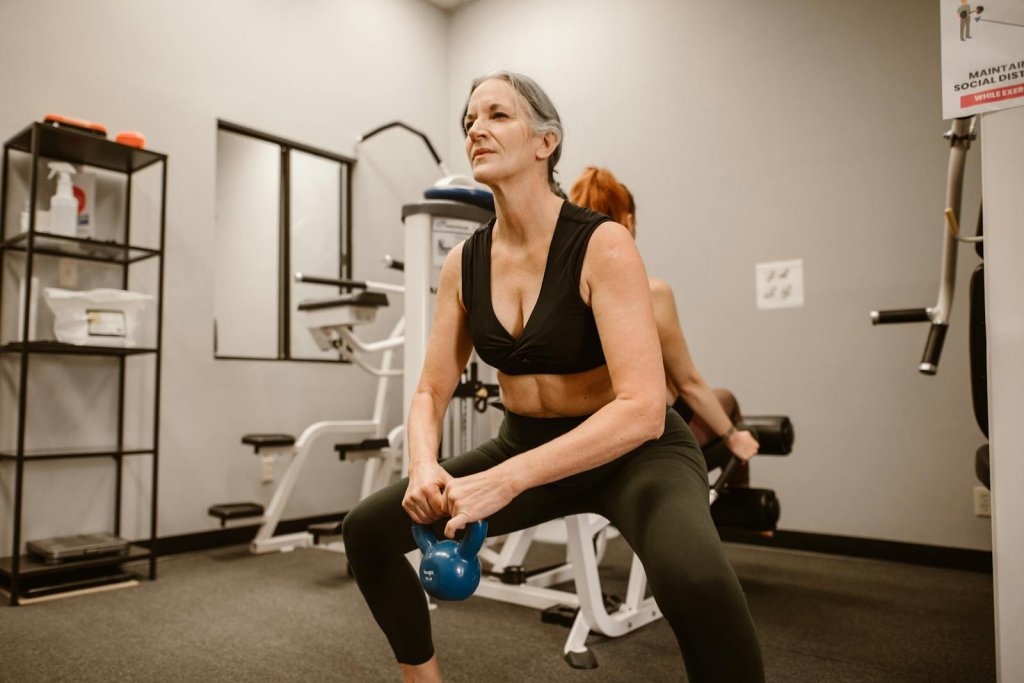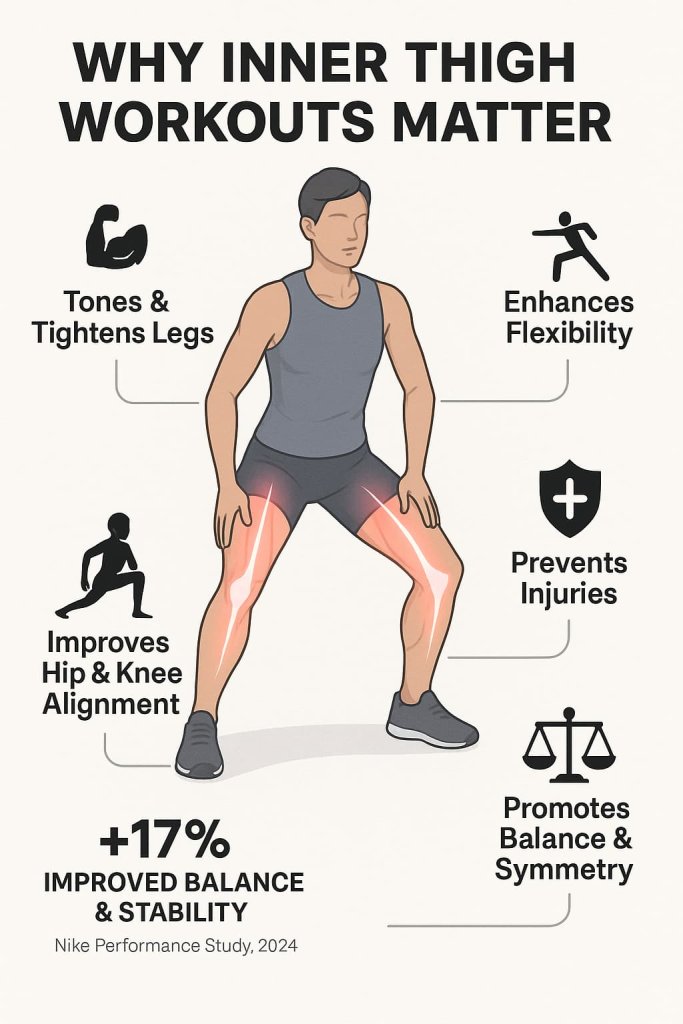Yes — you can tone and slim your inner thighs with the right exercises. However, it’s important to understand that a visible thigh gap depends largely on your bone structure, hip width, and body-fat distribution — not just workouts. Still, strengthening and toning your inner thighs (the adductor muscles) can make your legs look leaner, improve balance, and boost overall lower-body strength.

Training these muscles is key not only for aesthetics but also for preventing knee and hip issues. In this guide, you’ll discover the 12 best thigh gap workouts to tighten, strengthen, and shape your inner thighs — safely and effectively.
Why Inner-Thigh Training Matters
The Role of the Adductors
Your inner-thigh muscles — the adductor group — are responsible for pulling your legs toward your body’s midline. They stabilize your hips and knees, assist in balance, and support efficient walking, running, and squatting.
When under-trained, these muscles can cause instability, poor posture, and even hip or knee pain.

The Real Truth About the “Thigh Gap”
A thigh gap is the natural space between your inner thighs when standing with your feet together. But according to Healthline (2025), the gap’s visibility is primarily determined by pelvic width and leg bone alignment, not exercise.
That means:
- You can’t create a thigh gap through workouts alone.
- But you can tone and slim your inner thighs to achieve a leaner, more sculpted look.
- Focus on strength, posture, and balance — not unrealistic body ideals.
12 Best Thigh Gap Workouts
Here are 12 highly effective exercises that strengthen your inner thighs, promote muscle tone, and boost overall leg definition.
1. Sumo Squat
Why it works:
The wide stance activates your inner thighs (adductors) more than a traditional squat, while still engaging your glutes and quads. It also helps improve hip flexibility and stability, essential for lower-body symmetry.
Muscles worked:
Inner thighs, glutes, quads, hamstrings.
How to do it:
- Stand with your feet wider than hip-width apart, toes turned out about 45 degrees.
- Keep your chest tall, core engaged, and shoulders back.
- Lower down until your thighs are parallel to the floor or slightly below.
- Push through your heels and squeeze your glutes and inner thighs as you rise.
Trainer Tip:
Hold a dumbbell or kettlebell close to your chest for added resistance. Keep knees tracking over your toes to avoid joint stress.
2. Side Lunge
Why it works:
This move targets the inner and outer thighs while improving side-to-side mobility. It also strengthens your glutes and stabilizing muscles, enhancing balance and athletic performance.
Muscles worked:
Inner thighs, glutes, hamstrings, quads.
How to do it:
- Stand tall with feet hip-width apart.
- Step your right foot wide to the side, keeping your left leg straight.
- Bend your right knee, lowering your hips while keeping your chest lifted.
- Push through your right heel to return to standing. Repeat on the other side.
Trainer Tip:
Keep your bent knee aligned with your toes. Avoid leaning forward — think “hips back, chest up.”
3. Curtsy Lunge
Why it works:
The diagonal motion engages your inner thighs and glute medius, improving leg symmetry and balance. It also enhances hip stability and posture.
Muscles worked:
Inner thighs, glutes, quads, calves.
How to do it:
- Stand tall, hands on hips.
- Step your right leg behind and across your left, lowering into a lunge.
- Keep your chest upright and front knee behind toes.
- Push through your front heel to stand and repeat on the opposite side.
Trainer Tip:
Add a dumbbell in each hand or hold one at chest level to intensify the burn.
4. Side-Lying Inner Thigh Lift
Why it works:
This isolation exercise directly strengthens your adductors without putting strain on your back or joints. Ideal for shaping and toning.
Muscles worked:
Inner thighs (adductors).
How to do it:
- Lie on your right side, bottom leg straight, top leg bent with foot in front.
- Engage your core and lift your bottom leg upward slowly.
- Lower with control, keeping tension in your inner thigh.
- Perform all reps, then switch sides.
Trainer Tip:
Use ankle weights or resistance bands for extra challenge. Move slowly to increase time under tension.
5. Glider Sumo Squat
Why it works:
The sliding motion keeps your inner thighs under constant tension and improves coordination. Great for muscle control and sculpting.
Muscles worked:
Inner thighs, glutes, quads.
How to do it:
- Stand tall with feet together on a smooth floor or use gliders/socks.
- Slide one leg outward as you squat down into a wide stance.
- Press through your stationary leg to return to start.
- Repeat for reps, then switch sides.
Trainer Tip:
Keep your core tight and avoid shifting too much weight to the sliding leg.
6. Banded Side Walk
Why it works:
Resistance bands keep constant tension on your inner and outer thighs, improving hip and knee stability while sculpting lean muscle.
Muscles worked:
Inner thighs, glute medius, outer thighs.
How to do it:
- Place a resistance band around your ankles or just above knees.
- Bend knees slightly into a half-squat.
- Step laterally, maintaining tension on the band throughout.
- Take 8–10 steps each way per set.
Trainer Tip:
Don’t let your knees cave inward — keep the band tight for continuous activation.
7. Inner-Thigh Squeeze
Why it works:
Targets the adductors directly through controlled, static contraction, helping you develop strength and muscle tone.
Muscles worked:
Inner thighs, core.
How to do it:
- Sit or lie on your back with knees bent and feet flat.
- Place a small ball or pillow between your knees.
- Squeeze your knees together firmly for 2–3 seconds, then release slowly.
- Repeat for 15–20 reps.
Trainer Tip:
Hold each squeeze longer for deeper muscle activation. Combine with a glute bridge for a full lower-body burn.
8. Bridge with Inner-Thigh Squeeze
Why it works:
Combines glute activation with adductor engagement for a full posterior-chain workout.
Muscles worked:
Glutes, hamstrings, inner thighs, core.
How to do it:
- Lie flat on your back with knees bent, feet hip-width apart.
- Place a ball or small pillow between your knees.
- Lift your hips toward the ceiling, squeezing the ball and glutes at the top.
- Lower back down slowly.
Trainer Tip:
Hold the top position for 3–5 seconds each rep to intensify muscle recruitment.
9. Skater Lunge
Why it works:
This dynamic move combines cardio and strength training, burning calories while toning the thighs and glutes.
Muscles worked:
Inner thighs, glutes, hamstrings, calves.
How to do it:
- Stand tall, then hop laterally to one side, landing on one foot.
- Bring the trailing leg behind you into a curtsy position.
- Swing arms naturally for momentum.
- Repeat side-to-side continuously.
Trainer Tip:
Stay low and land softly. The lower your squat, the greater the inner-thigh activation.
10. Standing Leg Circles
Why it works:
Improves balance, flexibility, and core stability while engaging your inner and outer thighs through controlled circular motion.
Muscles worked:
Adductors, glutes, core, hip flexors.
How to do it:
- Stand on one leg and extend the opposite leg slightly forward.
- Draw slow, controlled circles with your lifted leg — clockwise and counterclockwise.
- Switch legs after each set.
Trainer Tip:
Hold onto a wall or chair for support until balance improves. Keep circles small and precise.
11. Single-Leg Deadlift (Outward Rotation)
Why it works:
Strengthens the posterior chain while engaging the inner thigh through slight leg rotation. It enhances coordination and balance.
Muscles worked:
Hamstrings, glutes, inner thighs, core.
How to do it:
- Stand on one leg with a slight bend in the knee.
- Hinge forward at the hips, keeping your back straight and other leg extended behind.
- Rotate your standing leg slightly outward to activate adductors.
- Return to standing by squeezing your glutes.
Trainer Tip:
Move slowly and keep hips square. Focus on maintaining alignment instead of depth.
12. Plie Walks
Why it works:
Maintains constant tension on the inner thighs and quads while improving muscular endurance and coordination.
Muscles worked:
Inner thighs, glutes, quads.
How to do it:
- Stand in a wide plie stance (feet wider than hips, toes pointed out).
- Lower into a squat and take small steps forward or sideways without standing up.
- Keep core tight and chest upright.
Trainer Tip:
Perform for 30–45 seconds without resting for maximum adductor endurance.
How to Structure Your Thigh Gap Workout Routine
| Level | Sessions/Week | Sets | Reps | Rest |
|---|---|---|---|---|
| Beginner | 2 | 2–3 | 10–12 | 45–60 sec |
| Intermediate | 3 | 3–4 | 12–15 | 30–45 sec |
| Advanced | 4 | 4 | 15–20 | 30 sec or circuit style |
Warm-Up: 5–10 minutes of light cardio and dynamic stretches (leg swings, walking lunges).
Cooldown: Static stretches like butterfly pose and seated side stretch for 1–2 minutes.
Progression: Increase band resistance or dumbbell load every 2–3 weeks for visible results.
Trainer Tips for Faster Results
- Combine strength training with 30 minutes of cardio (brisk walking, cycling, or jump rope).
- Maintain a balanced diet high in protein and fiber to support fat loss.
- Focus on mind-muscle connection during each move — feel the inner thighs working.
- Stay consistent: visible tone typically appears after 6–8 weeks of regular training.
FAQs
1. Can I get a thigh gap just from exercise?
Not always — your bone structure determines it. But inner-thigh training enhances tone and leg definition.
2. How long before I see results?
With consistent training and proper nutrition, expect noticeable changes within 6–8 weeks.
3. Do I need a gym?
No. Most exercises here can be done at home with minimal equipment like a resistance band or small ball.
4. Does cardio help reduce inner-thigh fat?
Yes — cardio helps burn overall body fat, which reveals muscle tone.
5. Is it safe to train inner thighs daily?
No. Give your muscles at least 48 hours to recover between sessions.
6. What’s the best diet for toning thighs?
A moderate calorie deficit with high protein (1.6–2.2 g/kg body weight) and plenty of vegetables supports lean muscle and fat reduction.
7. Can men also benefit from these exercises?
Absolutely — inner-thigh strength improves balance, running performance, and lower-body stability for all genders.
Conclusion
Achieving a toned, lean inner-thigh look doesn’t mean chasing an unrealistic thigh gap — it means building strength, stability, and shape. These 12 best thigh gap workouts help you tone effectively at home or in the gym.
Focus on consistency, controlled movements, and proper nutrition. Remember — every body is unique, and progress comes from discipline, not perfection.
Start today — your strongest, leanest legs are waiting.
References
- U.S. Dept. of Health & Human Services — Physical Activity Guidelines for Americans (2nd ed.)
https://health.gov/paguidelines/second-edition
Supports weekly activity targets and your strength + cardio framework. - American College of Sports Medicine — Progression Models in Resistance Training
https://journals.lww.com/acsm-msse/Fulltext/2009/03000/Progression_Models_in_Resistance_Training_for.26.aspx
Evidence-based guidance on sets/reps/load progressions for safe gains. - NHS — How to Warm Up Before Exercising
https://www.nhs.uk/live-well/exercise/how-to-warm-up-before-exercising
Practical warm-up steps that strengthen your safety/YMYL section. - StatPearls (NIH/NCBI Bookshelf) — Adductor Muscle Anatomy & Function
https://www.ncbi.nlm.nih.gov/books/ (search “Adductor Magnus” / “Adductor Longus”)
Authoritative anatomy/function details to support your “Role of the Adductors.” - Harvard Health Publishing — The Truth About Spot Reduction
https://www.health.harvard.edu/staying-healthy/the-truth-about-spot-reduction
Clarifies expectations around fat loss; perfect for “Myth vs Reality” framing.
